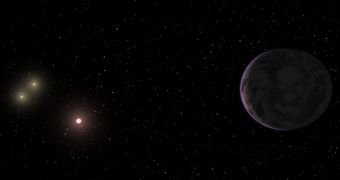A team of astronomers at the Carnegie Institution for Science, in Washington, DC, announces the discovery of an extrasolar planet that is potentially habitable. In fact, this particular world is the most likely to support both liquid water and life of all the exoplanets that were confirmed thus far.
What's more, this candidate is located very close to Earth, at a distance of about 22 light-years. Experts have dubbed it GJ 667Cc and say that it lies right within its parent star's habitable zone. This means that it's located close enough to the star for temperatures to allow the existence of liquid water.
CIS investigators Guillem Anglada-Escudé and Paul Butler led the new research team, which also included astronomer Steven Vogt, from the University of California in Santa Cruz (UCSC), Space reports. The group found the world to belong to the super-Earth class.
It has a mass about 4.5 times that of Earth, and takes around 28 days to orbit its star, in the Scorpius constellation. This means that it's located relatively close to the celestial fireball. For comparison, Mercury takes 88 days to complete a full orbit around the Sun.
“This is basically our next-door neighbor. It's very nearby. There are only about 100 stars closer to us than this one. It's right smack in the habitable zone – there's no question or discussion about it. It's not on the edge, it's right in there,” Vogt explains.
A statement released by Anglada-Escudé explains that the world is, in all likelihood, already supporting water on its surface. In addition, lifeforms may have also developed there over the eons, given the very Earth-like conditions.
“It's the Holy Grail of exoplanet research to find a planet around a star orbiting at the right distance so it's not too close where it would lose all its water and boil away, and not too far where it would all freeze,” Vogt says.
The reason why GJ 667C's habitable zone is so close to its surface is because it's an M-class dwarf star, whereas our Sun is a G-type yellow star. This means that the former produces less heat, therefore changing the location of the habitable zone closer to its surface.
Also interesting to note, the object is part of a triple-star system. “The other stars are pretty far away, but they would look pretty nice in the sky,” Vogt explains. The entire system was established to feature a rather different chemical composition than our own, especially as far as metals go.
The star wasn't expected to be able to host planets, because metal concentrations in the system are low. “These are the materials out of which planets form – the grains of stuff that coalesce to eventually make up planets – so we shouldn't have really expected this star to be a likely case for harboring planets,” Vogt explains.
The astronomy team used data collected by the European Southern Observatory (ESO), the W.M. Keck Observatory and the Magellan II Telescope's Carnegie Planet Finder Spectrograph instrument to conduct the study. The work will appear in an upcoming issue of the Astrophysical Journal Letters.

 14 DAY TRIAL //
14 DAY TRIAL //